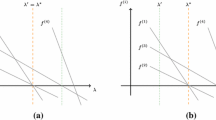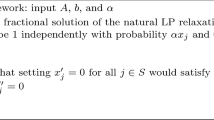Abstract
We consider fractional online covering problems with \(\ell _q\)-norm objectives as well as its dual packing problems. The problem of interest is of the form \(\min \{ f(x) \,:\, Ax\ge 1, x\ge 0\}\) where \(f(x)=\sum _{e} c_e \Vert x(S_e)\Vert _{q_e} \) is the weighted sum of \(\ell _q\)-norms and A is a non-negative matrix. The rows of A (i.e. covering constraints) arrive online over time. We provide an online \(O(\log d+\log \rho )\)-competitive algorithm where \(\rho = \frac{ a_{\max }}{ a_{\min }}\) and d is the maximum of the row sparsity of A and \(\max |S_e|\). This is based on the online primal-dual framework where we use the dual of the above convex program. Our result is nearly tight (even in the linear special case), and it expands the class of convex programs that admit online algorithms. We also provide two applications where such convex programs arise as relaxations of discrete optimization problems, for which our result leads to good online algorithms. In particular, we obtain an improved online algorithm (by two logarithmic factors) for non-uniform buy-at-bulk network design and a poly-logarithmic competitive ratio for throughput maximization under \(\ell _p\)-norm capacities.
Similar content being viewed by others
Notes
The result in [6] also applies to other convex functions with monotone gradients, but the competitive ratio depends exponentially on \(\max _{x\in \mathbb {R}^n_+} \frac{x^T \nabla f(x)}{f(x)}\).
References
Alon, N., Awerbuch, B., Azar, Y., Buchbinder, N., Naor, J.: A general approach to online network optimization problems. ACM Trans. Algorithms 2(4), 640–660 (2006)
Alon, N., Awerbuch, B., Azar, Y., Buchbinder, N., Naor, J.: The online set cover problem. SIAM J. Comput. 39(2), 361–370 (2009)
Awerbuch, B., Azar, Y., Grove, E.F., Kao, M., Krishnan, P., Vitter, J.S.: Load balancing in the \(\text{l}_{{\rm p}}\) norm. In: FOCS, pp. 383–391 (1995)
Awerbuch, B., Azar, Y., Plotkin, S.: Throughput-competitive on-line routing. In: FOCS, pp. 32–40. IEEE (1993)
Azar, Y., Bhaskar, U., Fleischer, L.K., Panigrahi, D.: Online mixed packing and covering. In: SODA (2013)
Azar, Y., Buchbinder, N., Chan, T.H., Chen, S., Cohen, I.R., Gupta, A., Huang, Z., Kang, N., Nagarajan, V., Naor, J., Panigrahi, D.: Online algorithms for covering and packing problems with convex objectives. In: FOCS, pp. 148–157 (2016)
Azar, Y., Cohen, I.R., Panigrahi, D.: Online covering with convex objectives and applications. CoRR abs/1412.3507 (2014)
Bansal, N., Buchbinder, N., Naor, J.: Randomized competitive algorithms for generalized caching. SIAM J. Comput. 41(2), 391–414 (2012)
Bansal, N., Pruhs, K.: Server scheduling to balance priorities, fairness, and average quality of service. SIAM J. Comput. 39(7), 3311–3335 (2010)
Bartal, Y., Fiat, A., Leonardi, S.: Lower bounds for on-line graph problems with application to on-line circuit and optical routing. SIAM J. Comput. 36(2), 354–393 (2006)
Blum, A., Gupta, A., Mansour, Y., Sharma, A.: Welfare and profit maximization with production costs. In: FOCS, pp. 77–86 (2011)
Boyd, S., Vandenberghe, L.: Convex Optimization. Cambridge University Press, Cambridge (2004)
Buchbinder, N., Chen, S., Gupta, A., Nagarajan, V., Naor, J.: Online packing and covering framework with convex objectives. CoRR abs/1412.8347 (2014)
Buchbinder, N., Jain, K., Naor, J.: Online primal-dual algorithms for maximizing ad-auctions revenue. In: ESA, pp. 253–264 (2007)
Buchbinder, N., Naor, J.: Online primal-dual algorithms for covering and packing. Math. Oper. Res. 34(2), 270–286 (2009)
Buchbinder, N., Naor, J.S.: The design of competitive online algorithms via a primal-dual approach. Found. Trends Theor. Comput. Sci. 3(2–3), 93–263 (2007)
Chan, T.H., Huang, Z., Kang, N.: Online convex covering and packing problems. CoRR abs/1502.01802 (2015)
Charikar, M., Karagiozova, A.: On non-uniform multicommodity buy-at-bulk network design. In: STOC, pp. 176–182. ACM (2005)
Chekuri, C., Hajiaghayi, M.T., Kortsarz, G., Salavatipour, M.R.: Approximation algorithms for nonuniform buy-at-bulk network design. SIAM J. Comput. 39(5), 1772–1798 (2010)
Chekuri, C., Khanna, S., Naor, J.: A deterministic algorithm for the cost-distance problem. In: Proceedings of the Twelfth Annual Symposium on Discrete Algorithms, January 7–9, 2001, Washington, DC, USA, pp. 232–233 (2001)
Devanur, N.R., Huang, Z.: Primal dual gives almost optimal energy efficient online algorithms. In: SODA, pp. 1123–1140 (2014)
Devanur, N.R., Jain, K.: Online matching with concave returns. In: STOC, pp. 137–144. ACM (2012)
Elad, N., Kale, S., Naor, J.S.: Online semidefinite programming. In: ICALP, pp. 40:1–40:13 (2016)
Ene, A., Chakrabarty, D., Krishnaswamy, R., Panigrahi, D.: Online buy-at-bulk network design. In: FOCS, pp. 545–562 (2015)
Gupta, A., Krishnaswamy, R., Pruhs, K.: Online primal-dual for non-linear optimization with applications to speed scaling. In: WAOA, pp. 173–186 (2012)
Gupta, A., Nagarajan, V.: Approximating sparse covering integer programs online. Math. Oper. Res. 39(4), 998–1011 (2014)
Helvig, C.S., Robins, G., Zelikovsky, A.: An improved approximation scheme for the group steiner problem. Networks 37(1), 8–20 (2001)
Huang, Z., Kim, A.: Welfare maximization with production costs: a primal dual approach. In: SODA, pp. 59–72 (2015)
Mehlhorn, K., Ziegelmann, M.: Resource constrained shortest paths. In: Algorithms—ESA 2000, 8th Annual European Symposium, Saarbrücken, Germany, September 5-8, 2000, Proceedings, pp. 326–337 (2000)
Menache, I., Singh, M.: Online caching with convex costs: Extended abstract. In: SPAA, pp. 46–54 (2015)
Meyerson, A.: Online algorithms for network design. In: SPAA 2004: Proceedings of the Sixteenth Annual ACM Symposium on Parallelism in Algorithms and Architectures, June 27–30, 2004, Barcelona, Spain, pp. 275–280 (2004)
Moreau, J.J.: Fonctionnelles convexes. Séminaire Jean Leray 2, 1–108 (1967)
Nagarajan, V., Shen, X.: Online covering with sum of \(\ell _q\)-norm objectives. In: 44th International Colloquium on Automata, Languages, and Programming, ICALP 2017, July 10–14, 2017, Warsaw, Poland, pp. 12:1–12:12 (2017)
Strömberg, T.: The operation of infimal convolution. Instytut Matematyczny Polskiej Akademi Nauk (1996). http://eudml.org/doc/271746
Author information
Authors and Affiliations
Corresponding author
Additional information
Publisher's Note
Springer Nature remains neutral with regard to jurisdictional claims in published maps and institutional affiliations.
A preliminary version of this paper appeared in the proceedings of ICALP 2017 [33]. Part of V. Nagarajan’s work was done while visiting the Simons institute for theoretical computer science (UC Berkeley) during the Algorithms and Uncertainty program. This research was supported in part by NSF CAREER Grant CCF-1750127.
Appendices
Deriving \(f^*_e(\cdot )\)
Recall that \(f_e(x)=c_e\Vert x(S_e)\Vert _{q_e}\) where \(x\in \mathbb {R}^n_+\) and \(S_e\subseteq [n]\). For any \(\mu \in \mathbb {R}^n_+\) we have
If \(\mu ({\overline{S}}_e) \ne {\mathbf {0}}\) then it is clear that \(f_e^*(\mu )=\infty \). So we assume \(\mu ({\overline{S}}_e) = {\mathbf {0}}\), in which case
Let \(\Vert \cdot \Vert _{p_e}\) be the dual norm of \(\Vert \cdot \Vert _{q_e}\). By the definition of the dual norm, if \(\Vert \mu (S_e)\Vert _{p_e}>c_e\), there exists \(z\in \mathbb {R}^{|S_e|}\) with \(\Vert z\Vert _{q_e}\le 1\) such that \(\mu (S_e)^Tz>c_e\). As \(\mu \ge 0\), we can ensure \(z\ge 0\). Then taking \(y=tz\) as \(t\rightarrow \infty \), we have
On the other hand, if \(\Vert \mu (S_e) \Vert _{p_e}\le c_e\), then by Hölder’s inequality, for any \(y\in \mathbb {R}^{|S_e|}_+\),
which implies that \(f_e^*(\mu )=0\).
Summarizing the above cases, we have for any \(\mu \in \mathbb {R}^n_+\):
Limitations of previous approaches in handling \(\ell _q\)-norm objectives.
The general convex covering problem is
where \(f:\mathbb {R}^n_+\rightarrow \mathbb {R}_+\) is a convex function and \(A\in \mathbb {R}^{m\times n}_+\). Its dual is:
where \(f^*(\mu ) = \max _{x\in \mathbb {R}^n_+} \{ \mu ^Tx - f(x)\}\) is the Fenchel conjugate of f. When f is the sum of \(\ell _q\)-norms, these primal-dual convex programs reduce to (P) and (D).
We restrict the discussion of prior techniques to functions f with \(\max _{x\in \mathbb {R}^n_+} \frac{x^T \nabla f(x)}{f(x)} \le 1\) because this condition is satisfied by sums of \(\ell _q\) norms.Footnote 1 At a high level, the analysis in [6] uses the gradient monotonicity to prove a pointwise upper bound \(A^Ty\le \nabla f(\bar{x})\) where \(\bar{x}\) is the final primal solution. This allows them to lower bound the dual objective by \(\sum _{k=1}^m y_k\) because \(f^*(\nabla f(\bar{x}))\le 0\) for any \(\bar{x}\) (see Lemma 4(d) in [6]). Moreover, proving the pointwise upper bound \(A^Ty\le \nabla f(\bar{x})\) is similar to the task of showing dual feasibility in the linear case [15, 26] where \(\nabla f(\bar{x})\) corresponds to the (fixed) primal cost coefficients.
Below we give a simple example with an \(\ell _q\)-norm objective where the pointwise upper bound \(A^Ty\le \nabla f(\bar{x})\) is not satisfied by the online primal-dual algorithm unless the dual solution y is scaled down by a large (i.e. polynomial) factor. This means that one cannot obtain a sub-polynomial competitive ratio for (P) using this approach directly.
Consider an instance with objective function \(f(x)=\Vert x\Vert _2=\sqrt{\sum _{i=1}^n x_i^2}\). So the gradient \(\nabla f(x) = x/\Vert x\Vert _2\) which is not monotone. There are \(m=\sqrt{n}\) covering constraints, where the \(k^{th}\) constraint is \(\sum _{i=m(k-1)+1}^{km} x_i \ge 1\). Note that each variable appears in only one constraint. Let P be the value of the primal objective and D be the value of the dual objective at any time. Suppose that the rate of increase of the primal objective is at most \(\alpha \) times that of the dual; \(\alpha \) corresponds to the competitive ratio in the online primal-dual algorithm. Upon arrival of any constraint k, it follows from the primal updates that all the variables \(\{x_i\}_{i=m(k-1)+1}^{km}\) increase from 0 to \(\frac{1}{m}\). So the increase in P due to constraint k is \((\sqrt{k}-\sqrt{k-1})\frac{1}{\sqrt{m}}\) for iteration k. This means that the increase in D is at least \(\frac{1}{\alpha }(\sqrt{k}-\sqrt{k-1})\frac{1}{\sqrt{m}}\), and so \(y_k\ge \frac{1}{\alpha }(\sqrt{k}-\sqrt{k-1})\frac{1}{\sqrt{m}}\). Finally, since \(\bar{x}=\frac{1}{m}{\mathbf {1}}\), we know that \(\nabla f(\bar{x})=\frac{1}{m}{\mathbf {1}}\) (recall \(n=m^2\)). On the other hand, \((A^Ty)_1 = y_1\ge \frac{1}{\alpha \sqrt{m}}\). Therefore, in order to guarantee \(A^Ty\le \nabla f(\bar{x})\) we must have \(\alpha \ge \sqrt{m} = n^{1/4}\).
Rights and permissions
About this article
Cite this article
Shen, X., Nagarajan, V. Online covering with \(\ell _q\)-norm objectives and applications to network design. Math. Program. 184, 155–182 (2020). https://doi.org/10.1007/s10107-019-01409-9
Received:
Accepted:
Published:
Issue Date:
DOI: https://doi.org/10.1007/s10107-019-01409-9




